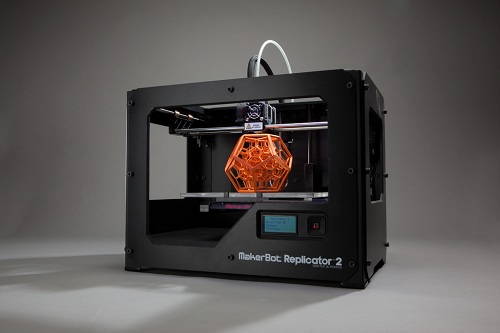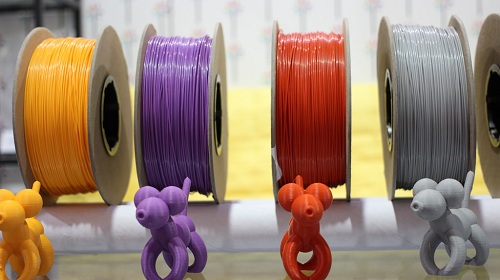A Guide to Understanding How 3D Printers Work

Of all the amazing technology on sci-fi television shows, the Replicator from Star Trek: The Next Generation, captures our imagination. It was a device that could create almost any object out of thin air, whether it was a hamburger, a spare mechanical part, or even life-saving medicine. While advancing technology brings the world ever closer to the fantastical creations of TV shows, the Replicator is a device much closer to reality than many other sci-fi tools. With the advent of 3D printing, creating three-dimensional objects with minimal effort is now a reality.
The technology supporting 3D printing is still in relative infancy, and yet people have already started to find novel and interesting uses for these amazing devices. Some models of 3D printers are made for consumer use and can fit on a desk and produce a number of objects with a variety of materials, while others are so big they can print structures for houses. In the medical world, 3D printers are used to replicate particularly difficult surgeries to help doctors practice in a realistic setting. In the food industry, 3D printing candy and other sweet treats allows bakers to create edible designs with a complexity that rivals the imagination.
3D printers are growing in popularity because they exist at the cross section of advanced digital technology and practical, physical objects that can make our lives better on a daily basis. For anyone interested in the burgeoning world of 3D printing, the following guide examines how 3D printers work, how they came about, and how they might develop in the future.
How Does 3D Printing Work?

The key to 3D printing is a process known as additive manufacturing, in which a printer builds an object layer by layer, using plastic, resin, metal, or other materials. Before it can get to that stage, however, the object must first exist as a 3D file.
A designer may take a 3D scan of an existing model if they want to replicate it, or they can also create a 3D model from scratch on special modeling software. Whether the object was originally scanned or designed on the computer, it has to go through modeling software, so that it can be broken down into layers which is sent to a 3D printer. This process turns the 3D image into layers of 2D images, necessary for 3D printers to work.
Once the design for the object has been sent to the 3D printer, the printer will use one of seven different methods including:
- Stereolithography(SLA)
- Digital Light Processing(DLP)
- Selective Laser Melting (SLM)
- Electronic Beam Melting (EBM)
- Fused Deposition Modeling (FDM)
- Selective Laser Sintering (SLS)
- Laminated Object Manufacturing (LOM)
Each of these methods has different strengths and weaknesses, but the method used in most consumer models is known as fused deposition modeling (FDM). In this process, the printer feeds a spool of plastic through an extruder nozzle. The nozzle is heated and melts the plastic, joining it to the previous layer, where the plastic instantly cools after it is laid down. As more and more layers are added, the object begins to take shape.
A Look into the History of 3D Printers
The processes for 3D printing came about in the 1980s, thanks to the work of scientists around the world. The first process was developed in Japan and involved using UV light to harden liquid polymers while creating a 3D object. Later, a scientist in the United States named S. Scott Crump developed, patented, and trademarked the FDM process that’s been adapted into many consumer-level 3D printers. Many industries have now adapted their own approaches to 3D printing that fit their respective manufacturing needs.
While 3D printing is becoming more accessible to the everyday consumer, many still don’t understand how 3D printers work.
What’s Next for 3D Printers?

As people continue to learn how 3D printers work, the popularity of personal printers will continue to grow. In the medical world, 3D printed organs may one day take over the market for organ transplants, removing the need to wait for organ donations. In the construction industry, 3D printing can stabilize the construct of many complex structures, ensuring the safety of the people who use them. Many other industries can benefit and advance from the development of more efficient and versatile printers.
There are several trends developing in the 3D printer market that will advance printer operation and enhance their versatility. The resolution of current 3D printers, for example, is one area that can benefit from improvements. Many current consumer 3D printers have relatively low resolution, meaning the final object may have a rough texture that shows the individually extruded layers. However, as the extruding process is refined, higher quality finished products will result. Another issue with 3D printers is the limit on color and material. In the future, 3D printers may be capable of using several materials simultaneously to create more complex objects.
Currently, creating original 3D models that can be interpreted by the 3D printer can take several steps. As the software develops, however, it will likely become easier to move from plan to printed object through better user interfaces and more intuitive modeling programs. Eventually, it may even be possible to use your smartphone to 3D scan an object which can then be printed on your printer in mere minutes.
Are 3D Printers Affordable?
As the technology for 3D printers develops, the models will become cheaper. For a while, there were only a few models on the market, each of which printed only crude objects. Now, some models are sold for hundreds of dollars—instead of thousands—and the quality of the items printed is much better. This brings the price into the affordable range for small businesses and interested hobbyists.
Like standard inkjet or laserjet printers, which were once too expensive for private individuals to own and operate, the 3D printer will soon enter the consumer market as an accessible and usable product. Once people understand how a 3D printer works they’ll likely make their own innovations and customizations as well. For anyone who wants to print their own gadgets, toys, and art, there is likely a 3D printer that fits your needs and budget.
If you are interested in learning more about printers, ink and toner cartridges, and other technological subjects, explore our blog! 1ink.com is dedicated to providing our customers with the highest quality products and engaging industry topics.
